- News
- Reviews
- Bikes
- Accessories
- Accessories - misc
- Computer mounts
- Bags
- Bar ends
- Bike bags & cases
- Bottle cages
- Bottles
- Cameras
- Car racks
- Child seats
- Computers
- Glasses
- GPS units
- Helmets
- Lights - front
- Lights - rear
- Lights - sets
- Locks
- Mirrors
- Mudguards
- Racks
- Pumps & CO2 inflators
- Puncture kits
- Reflectives
- Smart watches
- Stands and racks
- Trailers
- Clothing
- Components
- Bar tape & grips
- Bottom brackets
- Brake & gear cables
- Brake & STI levers
- Brake pads & spares
- Brakes
- Cassettes & freewheels
- Chains
- Chainsets & chainrings
- Derailleurs - front
- Derailleurs - rear
- Forks
- Gear levers & shifters
- Groupsets
- Handlebars & extensions
- Headsets
- Hubs
- Inner tubes
- Pedals
- Quick releases & skewers
- Saddles
- Seatposts
- Stems
- Wheels
- Tyres
- Health, fitness and nutrition
- Tools and workshop
- Miscellaneous
- Cross country mountain bikes
- Tubeless valves
- Buyers Guides
- Features
- Forum
- Recommends
- Podcast
review
£3,595.00
VERDICT:
If you want a single go-anywhere bike with an eye for adventure, this could be the bike for you
Weight:
11,420g
Contact:
At road.cc every product is thoroughly tested for as long as it takes to get a proper insight into how well it works. Our reviewers are experienced cyclists that we trust to be objective. While we strive to ensure that opinions expressed are backed up by facts, reviews are by their nature an informed opinion, not a definitive verdict. We don't intentionally try to break anything (except locks) but we do try to look for weak points in any design. The overall score is not just an average of the other scores: it reflects both a product's function and value – with value determined by how a product compares with items of similar spec, quality, and price.
What the road.cc scores meanGood scores are more common than bad, because fortunately good products are more common than bad.
- Exceptional
- Excellent
- Very Good
- Good
- Quite good
- Average
- Not so good
- Poor
- Bad
- Appalling
The Shand Stoater Rohloff is a British-made steel all-rounder. Built up with a Rohloff Speedhub and a Gates Carbon drive system, our review bike is priced £3,595, although you can go with a standard derailleur and chain setup if you prefer.

Here are five things you need to know about the bike.
1. The versatility
The best thing about the Shand Stoater Rohloff is its versatility. I've ridden it everywhere over the past few weeks. If you want one bike that can turn its hand to pretty much anything, this could be the bike for you. Okay, you might not want to take the Stoater road racing, but it'll make a good fist of most other stuff.
Shand say: "Designed for the pure enjoyment of go-anywhere riding, the Stoater is all about drop bar, two wheel adventure. Refined enough to be your main road bike but rugged enough for off road trails and singletrack, it could be the only bike you ever need."
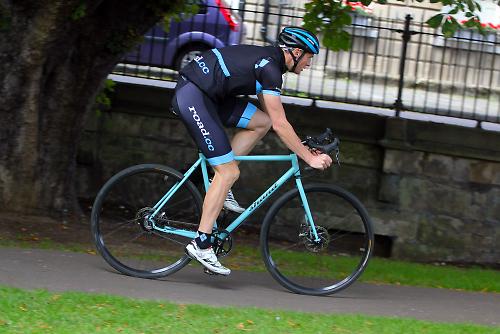
They're right.
The Stoater actually has a pretty short head tube –a diddy 135mm on the large model we have in for review, with a 575mm top tube. Don't let that fool you, though. The bike is fitted with a superb Chris King NoThreadset with external cups that add height to the front end, along with a riser stem that pushes the handlebar up further.
For maximum versatility you'd perhaps want to use the Stoater with a bunch of different stems, swapping them over according to the riding you're doing: a long and low stem for faster road rides, for example, a high rise stem if you're all-day touring, and so on.
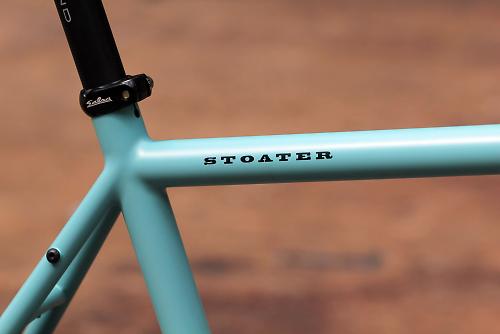
You might want to take a similar approach to the tyres. Our review bike came with Continental Cyclocross Speed 700 x 35C tyres on the Stans IronCross rims, and they're great if you want to mix things up and hit the bridleways, trails and towpaths.
They're not the fastest option if you want to get from A to B on the road, though, so you might want to have some skinnier rubber ready and waiting for times when you want to be more efficient across the tarmac.
The Stoater has about 55mm of space between the stays at the tyre point so 45mm tyres will fit fine with decent mud clearance. There's no reason why you couldn't race cyclocross on this bike if you wanted.
The other natural role for the Stoater is, of course, touring, adventure riding, bikepacking or whatever else you'd like to call it when you load up the bike and head off for days and nights in the back of beyond.
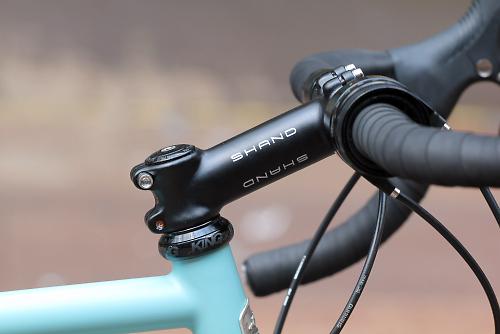
The Stoater comes with rack and mudguard eyelets front and rear, along with three sets of bottle cage mounts. Go for a complete bike and you'll get TRP Spyre disc brakes that provide enough stopping power to control a fully laden bike without any worries; Shand now offer the hydraulic TRP Hylex as a £150 upgrade.
The Spyre brakes are an excellent choice, offering superb power and modulation in all weathers. They're a cable-actuated (rather than hydraulic) dual-piston design, and they're simple to adjust; you just turn a barrel adjuster.
I was glad of all that power in steep situations, and you'll certainly appreciate it if you're carrying heavy loads. The modulation is equally welcome to avoid locking up on damp roads. These brakes do lose out in comparison to many hydraulic options out there, but they're the best cable-operated disc brakes out there right now.
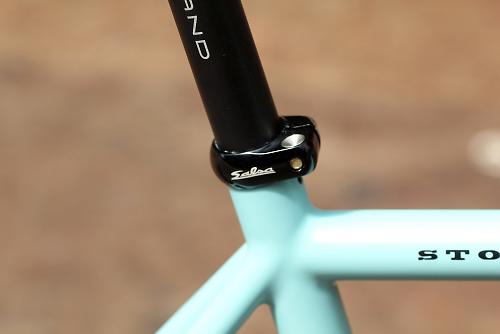
There you go, then. On road, off-road, cyclocross, touring: the Stoater has a lot of talents that should keep you busy for a while. If variety is the spice of life, it's a bit of a vindaloo.
2. It's well thought-out and well-executed
Shand build the Stoater from Reynolds 853 – seamless, air-hardened, heat-treated steel that's strong and resistant to damage – TIG welded in-house in Livingston, West Lothian (our review model was actually filet brazed but the Stoaters are now all TIG welded).
Shand haven't simply taken a Reynolds tubeset and used it across the Stoater range. Rather, they spec tubing sizes and wall thicknesses specifically for each frame size, the idea being that all the bikes will perform the same. So, the XL frame has tubes with thicker walls than an XS bike, while the XS gets a smaller diameter down tube.
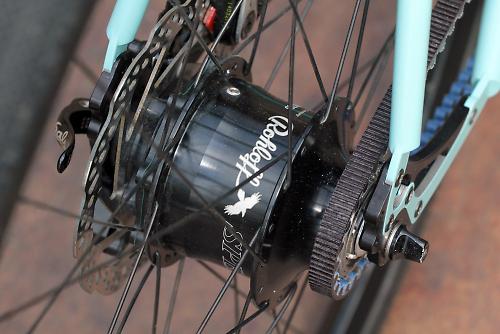
Our review bike has a Rohloff Speedhub and a Gates Carbon drive system (more on each of those in a mo) so it needs a means of tensioning the belt.
Previously, Shand offered two different versions of the Stoater: a derailleur model and a singlespeed/Rohloff model. Now they have updated the design so that it can run either, and it's simple for you to swap drivetrains yourself. They have done this by using a bottom bracket shell that can accept either a standard PressFit 30 bottom bracket or a PressFit 30 eccentric bottom bracket, and Paragon dropouts with interchangeable inserts.
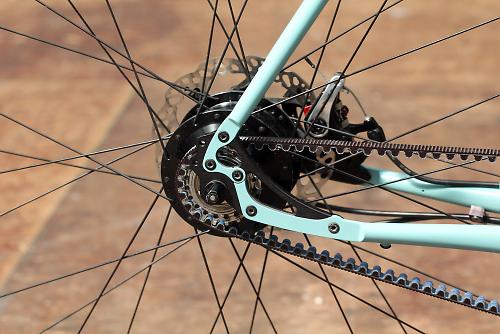
It's smart stuff that means that if, for example, you go for a Rohloff build but don't get on with it for any reason, you can simply change the dropout inserts and swap to a derailleur system without needing a completely new bike.
The Stoater comes with a sloping top tube and you get S-bend stays that offer plenty of heel and tyre clearance (see above for tyre clearance). The disc brake mount (assuming you spec disc brakes; you don't have to) is positioned within the rear triangle, leaving space for rack and mudguard eyelets. The fork gets mudguard eyelets too, along with mounts for a low-rider rack.
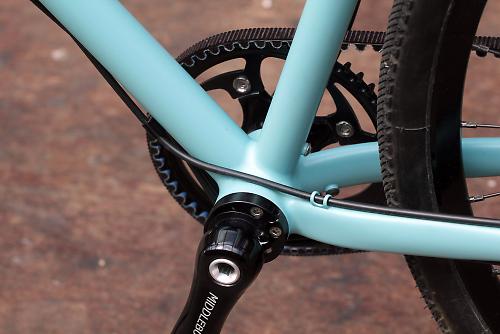
Little features like the binder slot at the top of the seat tube being positioned facing forwards rather than backwards to avoid it getting filled with gunk show that this is a bike that has been well thought-out and the execution is equally impressive. We'd be massively surprised if it wasn't still going strong after many, many years of use and abuse.
3. The Rohloff Speedhub
The Rohloff Speedhub has many fans who'd use nothing else and there's no doubting that the design is a work of engineering excellence.
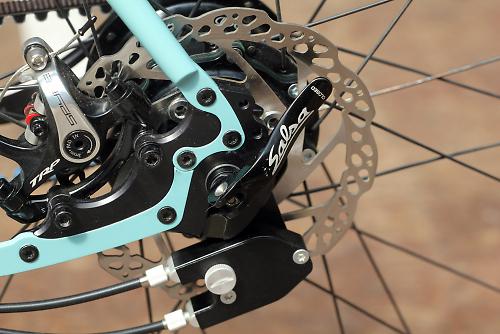
If you're not familiar with the Rohloff Speedhub, it's an internal hub gear system. If you want to know how it works, get yourself along to the Roholff website because it takes a bit of explaining. http://www.rohloff.de/en/products/speedhub/
The basic facts are that a Speedhub offers you 14 equally spaced gears via a twistgrip shifter, and the gear range is large –the highest gear is 526% the size of the lowest gear (for comparison, a derailleur system using 50/34-tooth chainrings and an 11-28 cassette has a gear range of 374%).

It's super-easy to find the right gear because everything is sequential – you never have to shift chainrings – and with most of the working parts sealed away from the elements inside the hub, durability is good and little maintenance is required.
Shand offer the Rohloff beltdrive system with three different levels of gearing. Our review bike came fitted with the 'low' gearing, meaning that it has a 50-tooth chainring (it's not really a chainring because there's no chain, but let's go with it anyway) at the front and a 20-tooth sprocket at the back. That gives development metres (the distance you travel forward with one crank revolution) of 1.5 metres to 7.9 metres.

A derailleur system using a 30-tooth inner chainring and a 32-tooth large sprocket would give you 2 development metres per crank revolution.
Put another way, if you were to pedal in the lowest gear of the Rohloff system at 90rpm, you'd do about 5mph.
You're not going to win the Tour de France at that speed, but that's not the point. The point is that you can get a heavily laden bike up very steep hills – not quickly, admittedly, but you will get there. I found myself seeking out steeper and steeper gravel tracks in the Cotswolds to challenge this tiny gear and I was on such ridiculous gradients by the end that the main problem wasn't the size of the gear, it was keeping the front wheel planted firmly on the ground.
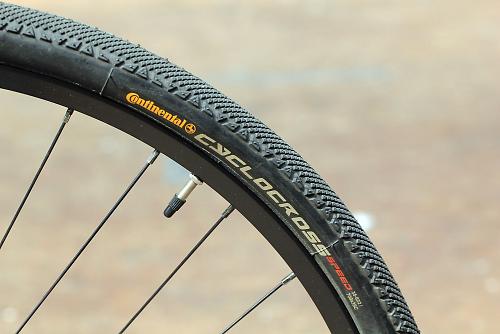
At the other end of the scale, the biggest gear is a fairly similar size to a 52-tooth chainring matched up to a 14-tooth sprocket – big but not massive.
If you want larger gearing, Shand can set you up with a 55-tooth at the front and a 20-tooth at the rear. That will give you development metres of 1.7 – 8.7. Or, if you want to go bigger still, they can give you a 19-tooth at the rear for development metres of 1.8 – 9.2.
For comparison, a compact chainset (with 50 and 34-tooth chainrings) and an 11-28-tooth cassette offers a development metres range of 2.6-9.8.
I think that's plenty about gear sizes!
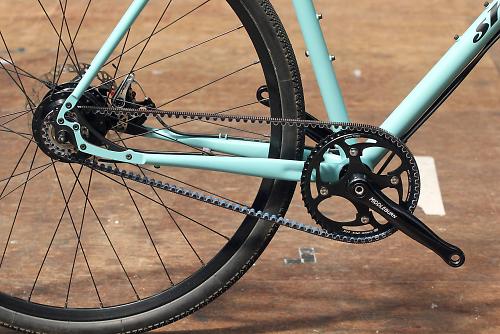
I must say that I find that the Rohloff gears can feel very different from one another, not just in their size – which is what you'd expect, obviously – but in terms of efficiency.
Plus, you can only change gear on the handlebar top, not from the hood or the drop, so there's a lot of hand shifting involved unless you go for the flat bar version (contact Shand for details of that).
Still, there are pros and cons to every system, and it could very well be that a Rohloff Speedhub is right for you. If not, no matter. Shand do the Stoater in a Shimano 105 build with derailleur gears and Shimano XT/Velocity A23 wheels for £2,745. You can also buy the frame and fork for £1,395.
4. The Gates Carbon drive system
The other unusual feature of our review bike is that it uses a Gates CDX beltdrive system. What's that? Essentially, instead of a chain you get a carbon-fibre belt that runs on a dedicated chainset and sprocket.
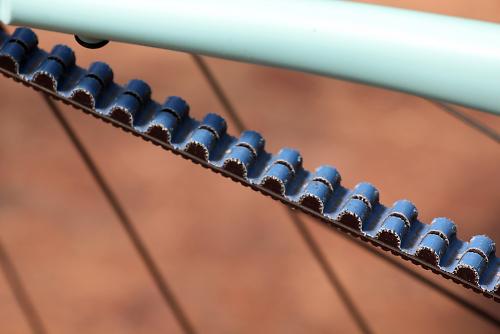
It makes for a smooth, quiet system, it's lightweight, and the belt should last for ages. Plus, the belt won't corrode and you don't need to bother with chain lube. If you want more on Gates, head over to their website.

I can't say I have any strong feelings for or against a Gates system. It works. The belt never comes off. That's all I care about, really. I don't find myself doing a whole lot to keep a standard chain running smoothly other than a regular clean and re-lube, but the lack of maintenance would be a definite plus if you head off on a multi-day adventure in the wilderness.
If you don't fancy the Gates beltdrive, the Stoater Rohloff is available with a standard chain system. It's £3,595 with beltdrive, £3,545 without, so there's really not much in it in terms of price.
5. Stuff that might make you think twice
I've already mentioned that a Rohloff hub might or might not be for you and the same goes for the Gates Carbon drive system. In both cases, you can simply opt for a different build, so no worries on either score.
The Stoater's 11.42kg (25.12lb) weight might be an issue if you're intending to use it mostly as a road or cyclocross bike, in which case it looks hefty compared to the opposition. Treat it as a tourer or adventure bike, though, and that weight is more on the money.

I guess the other potential issue is the flipside to the Stoater's versatility. If you're a Jack-of-all-trades you're generally a master of none. So, for example, the Stoater is never going to be as fast across the tarmac as a full-on road bike, as nimble through the mud as a lightweight cyclocross race bike, or as flickable through the singletrack as a mountain bike, although it'll handle all those situations well and be a whole lot cheaper than a stable of different bikes.
If you want a single go-anywhere bike with an eye for adventure, though, this could be the one for you.
Verdict
If you want a single go-anywhere bike with an eye for adventure, this could be the bike for you
road.cc test report
Make and model: Shand Stoater
Size tested: 57 - Green
About the bike
State the frame and fork material and method of construction. List the components used to build up the bike.
It's Reynolds 853 – seamless, air-hardened, heat-treated steel – TIG welded. Our review model was actually filet brazed but the Stoaters are now all TIG welded.
Frame TIG welded Reynolds 853. S-Bend stays for tyre and heel clearance. Sloping top tube. Front facing binder slot. Derailleur, singlespeed, Rohloff Speedhub, 142x12 and belt-drive compatible.
Fork Straight blades, lowrider rack mounts , mudguard eyes.
Headtube/headset 1-1/8in standard. Chris King headset installed on complete bike.
Tyres Continental Cyclocross Speed 700 x 35C
Wheels Rohloff/Hope Pro2 Evo/Velocity A23
Stem Shand
Bars Salsa Cowbell
Shifters Co-Motion
Brakes TRP Spyre
Chain Gates CentreTrack belt
Crank Middleburn RS8
Bottom Bracket Eccentric PF30 BB
Cassette Gates Beltdrive sprocket
Seatpost Shand
Seat Clamp Salsa Liplock
Tell us what the bike is for, and who it's aimed at. What do the manufacturers say about it? How does that compare to your own feelings about the bike?
Shand say:
Designed for the pure enjoyment of go-anywhere riding, the Stoater is all about drop bar, two wheel adventure. Refined enough to be your main road bike but rugged enough for off road trails and singletrack, it could be the only bike you ever need.
The Stoater is ideal for longer rides, fully loaded touring or a spot of bike packing. Disc mounts provide the stopping power and the chainstay mounted rear disc brake allows space for rack and mudguard eyelets.
If you're thinking about straying further off the beaten track the generous tyre clearance (up to 55mm) lets you fit some narrow 29er mountain bike tyres. If you're feeling a little competitive, fit a narrower knobby tyre and rock the local cyclocross race.
Our modular dropouts and cable guides future proof the frame allowing you to run an internal gear hub or singlespeed at some point in the future.
Rohloff Speedhub bike with disc brakes and Gates Carbon Belt drive
The Stoater Rohloff is designed around the Rohloff Speedhub, aiming to provide reliability and maintenance-free riding, perfect for long rides, touring or regular commuting. Disc brakes provide the stopping power (hydraulic brake options are available) and the chainstay mounted rear disc brake allows for rack and mudguards eyelets. Clearance for tyres up to 55mm is also possible.
Gates Carbon Belt Drive
The Stoater Rohloff comes as standard with a Gates Carbon Belt Drive system instead of a traditional chain, belt tension is adjusted using our innovative PF30 EBB solution. Rear dropouts can be changed to enable use of single speed or traditional derailleur drivetrains making this a truly versatile bicycle for every adventure.
Frame and fork
Overall rating for frame and fork
9/10
Riding the bike
Was the bike comfortable to ride? Tell us how you felt about the ride quality.
Yes, it felt comfortable and stable in all situations.
Was there any toe-clip overlap with the front wheel? If so, was it a problem?
A little but not so much that it was a problem.
Rate the bike for efficiency of power transfer:
8/10
Rate the bike for acceleration:
7/10
Rate the bike for high speed stability:
8/10
Rate the bike for cruising speed stability:
8/10
Rate the bike for low speed stability:
8/10
Rate the bike for flat cornering:
8/10
Rate the bike for cornering on descents:
8/10
Rate the bike for climbing:
7/10
The drivetrain
Rate the drivetrain for performance:
8/10
Rate the drivetrain for durability:
10/10
Rate the drivetrain for weight:
7/10
Rate the drivetrain for value:
7/10
Wheels and tyres
Rate the wheels and tyres for performance:
9/10
Rate the wheels and tyres for durability:
9/10
Rate the wheels and tyres for weight:
8/10
Rate the wheels and tyres for comfort:
8/10
Rate the wheels and tyres for value:
8/10
Controls
Rate the controls for performance:
8/10
Rate the controls for durability:
8/10
Rate the controls for weight:
8/10
Rate the controls for comfort:
6/10
Rate the controls for value:
8/10
Your summary
Did you enjoy riding the bike? Yes.
Would you consider buying the bike? If I were after a Jack-of-all-trades, yes.
Would you recommend the bike to a friend? Yep.
Rate the bike overall for performance:
9/10
Rate the bike overall for value:
7/10
Anything further to say about the bike in conclusion?
The price might seem high for a Reynolds 853 bike. A Genesis Equilibrium 853 frameset is £749.99 while the Stoater frame and fork is £1,395.
You need to consider, though, that you're getting a made-in-Britain frame that's suitable for a whole lot of different types of riding. Plus, if you go for a complete bike you get some high quality components like the Rohloff system, Hope front hub, Chris King headset, TRP Spyre brakes. They're not cheap.
Whether you should buy this bike is largely going to come down to whether you're going to make the most of its versatility. If you are, you're effectively getting several bikes in one and the value starts to sky rocket.
About the tester
Age: 43 Height: 190cm Weight: 75kg
I usually ride: My best bike is:
I've been riding for: Over 20 years I ride: Most days I would class myself as: Expert
I regularly do the following types of riding: commuting, club rides, sportives, general fitness riding,
Mat has been in cycling media since 1996, on titles including BikeRadar, Total Bike, Total Mountain Bike, What Mountain Bike and Mountain Biking UK, and he has been editor of 220 Triathlon and Cycling Plus. Mat has been road.cc technical editor for over a decade, testing bikes, fettling the latest kit, and trying out the most up-to-the-minute clothing. He has won his category in Ironman UK 70.3 and finished on the podium in both marathons he has run. Mat is a Cambridge graduate who did a post-grad in magazine journalism, and he is a winner of the Cycling Media Award for Specialist Online Writer. Now over 50, he's riding road and gravel bikes most days for fun and fitness rather than training for competitions.
Latest Comments
- Rendel Harris 7 hours 37 min ago
Interesting, I reckon one of those would certainly give the miscreants pause for thought, if they could hear themselves think.
- ktache 7 hours 43 min ago
New cycling show on Quest this evening. So that's a bonus.
- Rendel Harris 7 hours 51 min ago
I know, but you still have to be able to measure to within 1/16 of an inch (1.5mm) and given that it's an either way measurement you have to be...
- Nick T 8 hours 13 min ago
You would notice the overall bike weight increase, but that's not what we're talking about; he specifically states that you will save effort...
- cmedred 11 hours 25 min ago
Lost control of his car doing 40 mph through a 60 mph corner? Sort of begs for some questions as to how Wan obtained a license to drive in the...
- quiff 11 hours 32 min ago
I do understand that policing resources are limited and need to be prioritised, but do we really have to wait until a KSI before they take action?...
- andystow 12 hours 12 min ago
Still no mention of a driver....
- brooksby 14 hours 53 min ago
Electric car smashed up with 'big pole' in protest against Elon Musk (Bristol Post)...
- chrisonabike 14 hours 58 min ago
Just harness it. In European countries selfish and arrogant people are demanding better cycling facilities (for their convenience) and probably...






































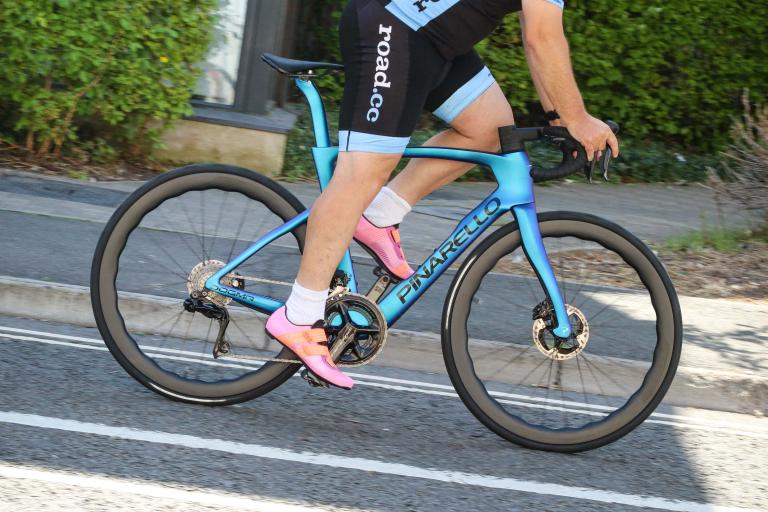
Add new comment
33 comments
Re the reviewer's comment on the very short head tube - maybe you're not taking into account the massive clearance on the fork, which raises the bar height considerably.
Not that it has any relevance to use on bicycles, but timing chains did not go out in the 1970s. VW, Honda, Mazda and others use them.
There are pros and cons both ways in cars and it probably has little transferable meaning for bikes.
I saw a Stoater in the wild for the first time at a CX race yesterday, and in amongst some very nice bikes (this was before they were all caked in mud and sand) it really stood out as a gorgeous bike.
I've seen several Shand bikes in the flesh, and agree with the comments here that the frames really are works of beauty. In all cases the owners have been very pleased with them. I've also visited the workshop and found Steven and Russ to be both really nice guys.
For me my only concern about the Stoater is that it's a bit too nice to take off road, and use on the crappy roads in the winter.
However, for long tours / high mileage commutes it would be great to have one.
For Audax and general road riding I hoping to be able get one of their Slinky Malinky frames at some point in the distant future.
I have to say this is a lovely bike but as some have already mentioned it's a lot of dollar for the one bike, I have a Giant carbon hard tail mtb and a boardman CX both of which I love. Maintenance is not that big a deal and they are both great bikes, and I would add have only cost me approx 2.5k which is one big one shy of the stoater.
If I had unlimited funds I might be tempted but at that price point you open up to other bespoke builders like Feather Donhou et al.
Another point which was picked up on was the genesis brand for those wanting steel, they are superb bikes and have been piloted around the world by folk and a variety of other places in between.
I too am not that keen on the colour.
That's just one of 23 colours available form our standard range!
http://www.shandcycles.com/paint/
@Airzound
thanks for your updated information - I am certainly glad that companies have got the Gates belt drive to work with the new belt style, and of course I know about Rohloff hub reliability.
But, the 2 years of cr*p we went through with angry customers buying the Trek Soho and similar Gates equipped affordable bikes, which were sold as "super reliable" by the manufacturers and Gates, meant my comments were certainly valid from that time period.
Your comments about cleaning and lubing chain based derailleur systems is somewhat at odds with my experiences; I commute 300km a week on my bikes as well as regular mountain biking in bad weather conditions, I've been riding mountain bikes on the dirt in the UK since 1986.
I cannot say its ever been an issue in terms of cleaning, lubing or wear and tear, that has made me want to get a hub gear or belt drive bike?
But as you said, I am not much of a mechanic...despite having been the workshop manager for Sigma Sport and several Specialized concept stores, flagship Evans stores, etc
Do you really leave your bike caked in crud though just because you don't have to clean the drive train?
I clean my wet weather bike after every ride, not just the drive train, the whole thing, it takes about 2 minutes to brush some Morgan blue on the chain and derailleurs then wash off with water after cleaning wheels and frame.
I can see the attraction for touring because you may not have the facilities to clean but for general use/commuting I don't see there's a massive benefit.
I guess there's less wear an tear so no chains/derailleurs/bottom brackets to replace as frequently but I guess the Rolhoff needs servicing periodically? What are the costs here?
I'm riding on roads and paved cycle tracks most of the time. With belt drive, full mudguards and mudflaps the bike does not get caked in crud.
I'm using the bike as everyday transport, no commute but generally multiple rides to get to things for work each day. It just doesn't work to ride a bike in work clothes and expect to wash it after every ride. Most evenings I'll be riding to a meeting and get home at 10pm ish. The bike gets put away as it is and then I'm rushing out the next morning to something or other.
The Rohloff just needs an oil change about once a year. Takes 20mins. I have inline oil points in the cables, do that every 6 months and have lasted 18 months since I fitted them. No sign of wear.
[ed: sorry tablet keyboard was playing up]
Saw them at the recent Bespoked and they are things of understated beauty. I take the point about multiple cheaper bikes (i do that too) but these bikes are really nice to look at. IF I was in the super high mileage adventure club I would grab one. IF I was loaded I would have one 'just because'. Most of us sadly will just not be able to afford it. The rohlhoff argument was been won already for that specific audience it's a no brainer. For most of us it's overkill and a fixie is a better solution with similar benefits on the maintenance front (assuming you live on the flat!).
I have fixie winter experience, with 2 years of everyday fixie winter use that I can compare with 2 years of everyday Stoater use with Rohloff and Belt drive.
In truth there is no comparison. The Rohloff/Gates belt drive combination requires significantly less maintenance as does the rest of the bike (because it runs so cleanly).
With Marathon Plus tyres and good mudguards you can realistically great through an entire winter with topping up tyres maybe once a month and a couple of overall washes if you are fussy.
Ok, I will take our word on that one... sadly I will never be able to afford to test that hypothesis!
Disclaimer: I've had a Shand Stoater for 23 months and ridden over 5,000 miles on it.
I use it for daily transport, for pleasure rides, for day rides, for touring. Mostly on-road but with some off road being planned eg http://bearbonesbikepacking.co.uk/WelshRideThing/ that will be part of a 1,500 mile tour between a variety of courses/events during a 3 month sabbatical next year.
It is not my only bike. I also regularly use a Whyte RD7 Suffolk (for faster group rides and day rides), a Bullitt Cargobike (for work, shopping etc) and a Pearson fixie (for fun and exercise).
My Stoater is a slightly older model. I wanted a very specific specification (focused on low maintenance, high reliability and practicality) Steven and Russ were able to build for me. It included Rohloff and Gates Belt drive plus as many British components as possible (eg Hope, Middleburn and Use). I also have Jones Loop H-Bar rather than drop bars and lots of nice electronics.
I mention all that to give my responses some context.
Seems to me that in the UK there is a common undervaluing of versatility, low maintenance, high reliability and local.
The combination of these makes for a specific category of bike.
The comments reflect a lack of understanding around how big a game change it is to have a bike that you can use everyday throughout the year without having to clean, maintain, repair or replace the drivetrain.
A good example was the Strava Rapha Festive 500 Challenge at the end of 2012 See http://42bikes.warnock.me.uk/2013/01/02/strava-rapha-festive-500-challen...
The points about the "additional cost of the maintenance a derailleur system will occasionally need" are way off the mark. Yes I have used plenty of derailleur systems, look at my Trek after completing LEJoG in the summer of 2012 http://42bikes.warnock.me.uk/2012/07/22/lejog-bike-recovery/
While I have had one free belt replacement since the bike has been fully dialled in there have been no issues with the belt at all and it is a delight to have a bike that is silent, can be ridden in a suit (without trouser clips) and needs no chain cleaning and oiling.
I continue to be delighted with my Stoater and am looking forward with excitement to my 1,500 mile sabbatical tour next year. Of course by then I'll have put in a few more 1,000's of reliable miles.
Thanks for your posts, very informative and what I suspected. Much more helpful than the review here.
Re deraillieur drive train it is the investment in time to maintain it more than the cost, although I go through about two chains and a cassette each year, chain rings last longer providing the chain is kept well lubed, you don't ride with a worn out stretched chain and you don't push heavy gears. I ride 250-300 miles a week and would love a Stoater with Rohloff and belt drive. Primarily because I hate cleaning and re-lubing the deraillieur and chain transmission even if it is only every 4-6 weeks. Deraillieurs and chain don't do wet and crud. The only issue for me with the Rohloff Stoater would be the weight of the Rohloff hub, but I guess it can't be that much heavier than the combined weight of deraillieurs front and rear, cassette, chain and chain set even if they are light such as Ultegra? The Stoater frame is a work of art. The thought of having a bespoke bike such as this is very attractive. I too like you have other bikes, but 'am still searching for the perfect low maintenance everyday bike that is a real game changer. Maybe I have found it, just need to save up.
Thanks. I have now written an ebook about the process that led to my Stoater: "A Bike for Life"
Well you are doing a lot more miles than me. Still the belt is supposed to be good for a couple of hundred thousand kilometres so the savings in time and parts should be pretty good!
There are weight comparisons available. Compared to a road double it is going to be a bit heavier and the weight is at the back and is rotating - all of which will slow you down. But not overall it seems to me when you factor in the maintenance time.
For all the naysayers you fundamentally miss the point of the bike. If you ride high mileages for your commute or are doing a RTW tour then this bike is the one. If you like the chore of regularly cleaning and re-lubing a filthy dirty open chain deraillieur transmission then this bike is NOT for you. Move along.
@Hampstead_Bandit comparing this bike to the Trek Soho you are talking out your behind. You can't be much of a mechanic if you don't know how good the Rohloff hub is or about Gates' drive belts systems.The Stoater uses the 14 speed Rohlofff hub which is second to none in the world of internal hub gears which many many RTW cyclists opt for as it is so robust and reliable. Rohloff's customer service is also brilliant. Their hub costs approx £1k if you buy it stand alone, it is far far better than a crummy Shimano Nexus or Alfine hub that Trek used on the Soho. The Soho used a cheap massed produced frame which suffered alignment problems where as the Shand Stoater is a hand built 853 frame. Chalk and cheese. And also the Gates belt used on the Stoater is the much more recent CDX version which does NOT come off as it has a central groove in the belt which the front and rear sprockets lock into unlike the earlier CDC belts as used by Trek on the Soho if I am right. The wear of rear sprockets was an issue with very early Gates CDC belt drive systems as fitted to bikes such as the Trek Soho which used either the Nexus or Alfine hubs. The belt was liable to slipping off if not correctly aligned as you correctly state, but these problems do NOT affect the Stoater with Rohloff hub which uses the Gates/Rohloff front and rear CDX sprockets for the corresponding CDX belt NOT the CDC system which had problems. The Trek Soho is a massed produced cheap bike which was not particularly good. It even had a cable drum front brake iirc. How crap is that! This is 2014 not 1934. In comparison the Trek Soho is a tired old Trabant compared to the Shand Stoater which is a BMW M5. If Gates' belt drive is so bad why has practically every single car in the last 30-40 years been fitted with a cam belt? Because they are strong and durable. The only additional thing I would like to see is a fully enclosed belt cover as per car cam belt covers but for bicycles. Car timing chains went out in the 1970s except with BL cars which continued to use them in the Leyland Mini and all their other crap cars they used to make. They were noisy, inefficient and wore out too quickly - crap longevity. A belt can spin at a much higher speed and doesn't need lubrication so lasts much longer.
The Stoater is a hand built thoroughbred, that is why it is has a £3.5k price tag although the more you think about it more suited and better value for everyday riding it is than a similar£3.5k plastic wannabe road bike. Although it costs a lot more than a cheaper massed produced factory bike you get what you pay for and the bike is definitely of exceptional quality and low on maintenance go anywhere type of bike. I am sick to death of cleaning and re-lubing a deraillieur drive chain as they are only suited to dry and sunny weather which the UK has very little of so whether riding a high mileage commute or on a world tour in the back of beyond you don't want the hassle of keeping a deraillieur system running sweetly, so the Shand Stoater is top on my list of dream bikes.
Just because the Stoater has a belt drive doesn't mean you can let it get covered in crud and crap as you would a chain. In fact running either belt or chain on a Rohloff hub I would definitely have a fully enclosed belt/chain guard to protect and keep either clean just like those used by Pashley or Dutch commuter bikes. And adjustment and tensioning of the belt is a piece of piss on the Stoater as it has vertical drops and an eccentric bottom bracket. Problems arise when the frame has horizontal rear drop outs keeping the axle and belt line dead true. But with the CDX belt system it is a lot more forgiving than the older inferior CDC belt drive system.
Also you can now get rapid fire shifters (sold by Tout Terrain) for the Rohloff hub so could have the Shand Stoater as a flat bar version with bar ends.
http://bikefix.co.uk/cinq5-rohloff-shifter
Other similar bikes to the Shand Stoater are the Co-Motion Americano or a Tout Terrain Fifth Avenue GT both with Rohloff hubs and belt drive. There is also the Milk Bike RDA and Genesis Day One but they use the much cheaper and lower quality Shimano Alfine hub and the frames are much cheaper and lower quality than the Stoater's 853.
IIRC Mark Beaumont rode a Santos Travell Master with a Rohloff hub and Gates belt drive on his record breaking RTW ride a few years ago. He had no problems with it.
You makes your choice and pays your money. This is one bike I would love in my stable.
Finally road.cc review a bike that is low maintenance, practical and suited to everyday riding what ever the weather. They only did a part test as the other reason for buying this bike is touring which means carrying a full set of panniers and bar bag. Why haven't they tested it carrying luggage as this is also what it is made to do? This is an epic fail. And why not 5 stars? However I shall now go and lie down in a darkened room as this has been far too much excitement all at once.
Can I have my 3 minutes back please?
It took you 3 minutes to read a short paragraph .
.
Nope, decided to edit the quote down for the sake of everyone else (and the internet).
While your reasoning for automotive timing belt use is correct, consider that the conditions of transmitting power from the pedals to the rear hub of a bike are quite different. Car timing belt: low torque, high rpm. Bike power transmission: high, spiky torque, low rpm. CDX and the need for a precisely adjustable EBB frame system, as you mention, confirms my understanding that perfect belt alignment and tension is critical to achieving belts' potential. And what happens to tension when the sprockets are covered in grime?
Belts per se aren't bad, but on bikes seem like a solution looking at the wrong problem. Maybe e-bikes are their natural habitat?
There's also a Gates/Rohloff option on the Tout Terrain X-Over, which is a lot closer to the Stoater. I had a good look at belt bikes when looking for a replacement for my Day One Alfine (chain), but decided to go for derailleur gears due to the rear wheel weight of the Alfine and the horrible Versa shifter.
Haha, have a good rest mate.
Why is it Bianchi coloured?
Ah...that's why I don't like it.
Probably worth comparing the Rohloff’s 526% range with typical MTB drivetrains as they offer a closer comparison:
Using Shimano MTB components, with 700x32
1) 44/32/22 with 11/28 = 509%, 90rpm = 5.6mph
2) 44/32/22 with 11/30 = 545%, 90rpm = 5.3mph
3) 44/32/22 with 11/32 = 581%, 90rpm = 4.9mph
4) 44/32/22 with 11/34 = 618%, 90rpm = 4.6mph
This shows that Rohloff is a tad short of the range of a mountain triple.
By mixing trekking and MTB sizes it is possible to get much bigger ranges than the Rohloff:
5) 48/xx/22 with 11/32 = 634%, 90rpm = 4.9mph
6) 48/xx/22 with 11/34 = 674%, 90rpm = 4.6mph
where xx = 32 or 36
For adventure touring the gear maintenance thing kind of starts to make sense, but you could carry more chains, have a more spokes in the rear wheel (Rohloff only available with 32), and still have less weight, a more efficient drive, and a lot more gear range. And if the whole thing gets stolen, it won’t be quite as devastating.
Maybe it is one of those things for which you can only be convinced by having done an expedition on one.
That's not correct I'm afraid. Available in 36H too.
Sorry I’m a bit behind the times. As of Nov ’11 they do 36 spoke also.
I don't know much about belt drive bikes and how good the drivetrain is, but the frame looks great quality and the geometry looks speedy and fun.
I appreciate that the article recognised the limitations; my comment was more general than that. In a world of specific choice with regard to bicycles, the need for a do-it-all type of bike is perhaps questionable, taking finance, space, wife etc., into account.
@crikey
you make a valid point about Gates belt drives - I've worked as a mechanic for a couple of shops that sold Trek Soho and other bikes with belt drives and we had nothing but trouble with durability of both the belt itself, and more importantly the drivetrain components - specifically the rear cog, the freehub and the bottom bracket. It got so bad the bikes started arriving with a set of spares to convert the entire bike to bushingless chain drive.
Belt tension on the Gates was critical - there is actually a belt tension tool to set it up properly, but most shops don't have it, and consumers certainly don't have that tool to reset the belt after getting a puncture and taking off the back wheel!
Too loose and the belt 'ratchets' under power (slips over rear cog paddles), too tight and the tension quickly ruins the freehub mechanism and bottom bracket bearings. The aluminium alloy rear cog also quickly disintegrated against the steel freehub body of most hubs, Trek had to supply a hybrid cog with steel core and aluminium outer to get around this issue. Seen many splits belts too, and they are not cheap
Chainline also has to be spot-on, otherwise the belt "crabs" (continually tried to walk sideways off the rear cog and front cog meaning its often rubbing against the front cog guard.
Belts are really a solution to a problem that never existed?
@hampstead_bandit
Thank you so much for telling us about the problems faced by the Gates belt drive. I have faced exactly these problems and I've now gone back to a chain.
I have until now only read only good things about the Gates system. I see more and more bikes being released with this drive train. I'm glad to see I'm not the only one with this problem.
I bought a Trek Soho from a LBS back in 2010. It worked great for a year. I then experienced the problems you mention. Trek then replaced the bike at no charge (after a six month wait). I then rode the new Trek Soho for another year. The problems reappeared. I then waited for an entire year during which time Trek told me they wanted to replace the Shimano internal hub with a SRAM internal hub.
After waiting a year during which time I wrote letters to the CEO of Trek as well as on the Facebook page of Trek and Gates, they decided to give me yet another bike (bike number 3). They didn't ask for bike number 2 back, so I gave it to a friend who doesn't go up hills.
I was happily riding bike number three for a year. I really enjoy the clean belt.
In January of this year, bike number three broke down. The LBS and Trek again kept this bike for five months.
They have now given the bike back to me with a chain and a Shimano hub.
I really loved the clean belt, but it just didn't work for me. Perhaps this Steel frame from Scotland won't have any problems with the belt. It doens't seem worth it to risk it.
My father's 1966 Schwinn Paramount can be fixed by any bike shop. I went out of my way to buy a big brand (Trek) from the local bike shop exactly because I wanted to have the chance to go back if there were any problems. It's been a nightmare.
There are documented issues with the longevity of belt drives under heavy usage; I'd always opt for a chain and derailleur system for ease of replacement.
Pages